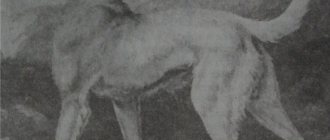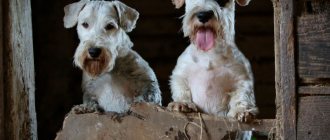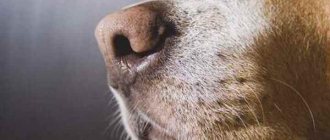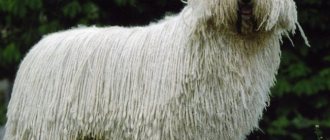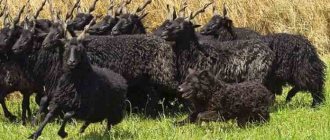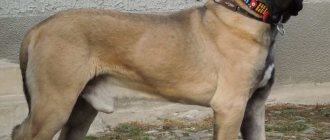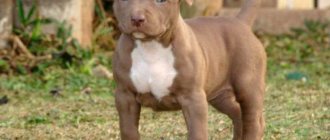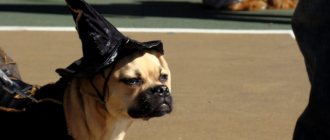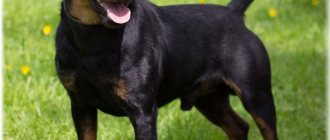Story
The Red Chinese Shepherd is a fairly young breed, its homeland is Yunnan Province. During the cultural proletarian Chinese revolution (60-70s), the country's dog breeding suffered enormous damage, as dogs began to be considered a luxury and a “class symbol”, most owners had to give up their pets, and some breeds were almost completely destroyed.
In recent decades, interest in cynology has returned and German shepherds began to be actively imported to China from Germany, which they began to cross with local dogs, including wolf hybrids (wolfdogs) and Chinese Molossians, thus obtaining new shepherds suitable for work in the army and law enforcement agencies and for exhibitions and keeping as pets.
Reviews
Some owner reviews:
- “Frankly speaking, I did not notice any difference in the behavior of the German and Chinese shepherds. I was there for a long time, but out of curiosity I also purchased an oriental copy. Because of their flattened appearance, they seem more touching and funny."
- “Difficult to train and aggressive, wolf genes take their toll. I would definitely not recommend it as a pet. But if you need a good service dog, then you can try it. But training and education must be tough.”
Description of the breed
Chinese Shepherds can be divided into 2 distinct varieties.
The Kunming Shepherd (recognized by China in 1988, not recognized by the FCI) is very similar in appearance to the German Shepherd, but is smaller in size, lighter in frame and head, and less pronounced in the angulations of the limbs.
- Weight does not exceed 37 kg, height at the withers 60-67 cm, medium-length coat with undercoat, black, zonal or black color, lively temperament, closer to choleric, very hardy, working qualities are pronounced. They are used by law enforcement agencies not only to detain criminals, but also as bloodhounds.
German Shepherd of Chinese breeding - conditionally it can be called a separate type of German Shepherd. In appearance, an admixture of at least a Tibetan mastiff is clearly visible, which is manifested by a much heavier bone structure, a massive square head with hanging jowls, very large sizes (the weight of some individuals reaches 70 kg!) and bright color.
German Shepherd
The angles of the joints of the limbs are strongly pronounced, the movements are typical. The temperament of such shepherd dogs is more similar to Molossians: they are balanced, slower, and have good guarding qualities.
Despite the striking differences from the classic type, these shepherd dogs have their fans, are successfully shown at exhibitions and sold from China around the world.
Representative of Chinese Shepherds.
Chinese Shepherd. A little history
So, everything in order. The Chinese Shepherd is a very interesting working breed. It began to be developed during the Cultural Revolution. Then, when many pure Chinese breeds began to gradually disappear.
The Chinese Shepherd is also called the Kunming Wolfdog. In honor of the capital of the province, where it was developed in the early 50s - the city of Kunming. At that time, ten German shepherds arrived from Beijing to Yunnan. They were crossed with local dog-wolf hybrids (wolfdogs or wolfdogs). A little later, dogs were again sent from the GDR for selection. Wolfdogs were also selected in Guizhou, a neighboring province. The breed was officially recognized in 1988. She became quite popular.
Character
Representatives of this Chinese dog have a unique character. They are able to make independent decisions, without human intervention, prefer to dominate, have a love of freedom and stubbornness.
They need an owner with a strong character who can tame the dog’s temper. An intelligent animal that requires constant training. Emotionally attached to a person, tries to please. During the period of character formation and as he grows up, he becomes calmer.
He does not show aggression towards his own people and is friendly. He is wary of strangers, but does not show it. In a moment of danger or when protecting the owner, he manifests himself as an ardent defender and a dangerous opponent.
He is calm and patient with children, ready to forgive a lot. If there is a child in the family, it is necessary to arrange a place for the dog where he can go if he gets tired.
Active, loves activities with mental activity, perfectly alternating with entertaining games. Emotionally stable. Loves new places, tolerates almost any climatic conditions without harm to health.
Maintenance and care
Thanks to its “universal” wool with a dense undercoat, this breed can live year-round both in a spacious enclosure with an insulated booth, and in an apartment. Ideal - a country house with the possibility of free walks in the local area.
Walking should be at least 2 times a day with good physical and mental exercise. Like any other dog, left to its own devices 24 hours a day, it can develop a lot of bad habits, ranging from damaging property and endless barking, to obsessive behavior such as non-stop wandering in circles around the enclosure and chewing itself.
There are no special feeding requirements for Chinese Shepherds; they are rarely prone to food allergies. If the owner chooses natural food for his pet, then the diet should consist of meat, offal, a small amount of fresh grated vegetables/fruits and cereals, 1-2 times a week - fermented milk products and fish.
- Large raw cartilage can be given as a treat and for cleaning teeth. With a balanced diet, vitamin and mineral supplements are not required, with the exception of the period of teeth change in puppies and pregnancy and lactation in bitches.
If preference is given to industrial food, then you need to choose based on weight and needs (puppy/adult dog, activity level, etc.). Mixing dry food and natural food is not recommended.
It is important to know that large dogs have a tendency to volvulus, so overfeeding is unacceptable for them.
- The coat does not require special care; weekly brushing and bathing as needed is sufficient. Shedding occurs twice a year; in bitches, extraordinary shedding occurs after whelping.
- Nails: accustom the puppy to the procedure from a very young age, cutting nails 1 – 2 times a month.
- Eyes and ears: treat with a cotton swab using specialized products or with a decoction of simple chamomile. Once a week is enough.
- Teeth: regularly inspect for caries, give specialized bones - treats to cleanse plaque.
Balanced diet
Dog food should be natural, or at least mixed. Dry food is not suitable for animals and significantly reduces life expectancy. The basis of your pet’s menu should be meat:
- chicken;
- horsemeat;
- beef.
You should avoid eating pork, as this type of meat causes intestinal obstruction. It is recommended to choose meat with plenty of tendons. This will be healthier for your dog than tenderloin or fillet. The following by-products should be included in the breed's diet:
- liver;
- lungs;
- hearts;
- kidneys
A healthy dish for an animal is porridge with the addition of butter. Buckwheat and rice are preferred. You should also add various vegetables to the menu. They can be served raw or baked. Some of the healthiest vegetables include the following:
- pumpkin;
- carrot;
- beet;
- zucchini;
- cabbage;
- spinach;
- lettuce leaves.
Several times a week you are allowed to pamper Chongqing with fish and eggs. About 20% of the diet should be dairy products. Milk and cottage cheese are especially beneficial for the breed.
Rye crackers and cheeses are treats for your pet. You should approach smoked products with caution. Their amount in the dog’s diet should be minimal. The following foods should be avoided:
- potato;
- corn;
- bread;
- beans;
- peas;
- flour and salty dishes.
An adult should be fed several times a day. The number of meals for a puppy is 5-6 per day. Don't forget to add vitamin supplements to your diet. Fish oil will be very beneficial for puppies.
Health Features
The Kunming Shepherd is a fairly strong breed, but, like its closest relative, the German, it can have problems with the musculoskeletal system and spine. Average life expectancy is 12-14 years.
The Chinese German Shepherd is weaker in health compared to its “sister”; hip and elbow dysplasia, various back diseases are very common, less often - otitis media, problems with the gastrointestinal tract, heart, as well as autoimmune diseases, which is associated with its origin (blood flow of mastiff-like dogs). Average life expectancy is 9-12 years.
HISTORY OF THE BREED
Despite the fact that dogs are often depicted in Chinese paintings, there is practically no mention of them in the literature. In addition, interest in indigenous breeds has only emerged in China in the last 10-15 years. In fact, practically nothing is known about the breed. The only fact that can be stated is that the breed is ancient and has always been associated with the cities of Chongqing and Sichuan. Based on visual similarities (blue tongue and many wrinkles), it can be assumed that this breed is descended from other Chinese breeds such as the Chow Chow and Shar Pei.
Training and education
Very trainable, quite versatile, with good guarding qualities and excellent instincts, distrustful of strangers, suitable both for service and sports, and as a companion to experienced people. It is better to start training as soon as the puppy moves to you - first at home, then after all vaccinations, classes with an experienced instructor are recommended.
- The direction of training must be chosen based on the puppy’s temperament and inclinations. Socialization begins as early as possible, periodically visiting crowded places with the dog, introducing them to transport, various noises and giving the opportunity to communicate and play with their own kind.
When choosing the gender of a Chinese Shepherd, it is important to take into account that males have a tougher character and are prone to fights with their relatives; this requires more attention from the owner to education.
Price
The cost of the puppy will depend on the breed type and origin, and ranges from 500 to 2000 euros, not including delivery, if the dog is purchased from local Chinese kennels. In Russia and neighboring countries, the Chinese Shepherd is very rare and is not popular.
When buying a puppy, you should be sure to conclude a sales contract in English and ask the breeders for confirmation of origin and pictures of the parents for joint dysplasia.
Export from the country is possible one month after rabies vaccination with a full set of accompanying veterinary documents and an export permit.

